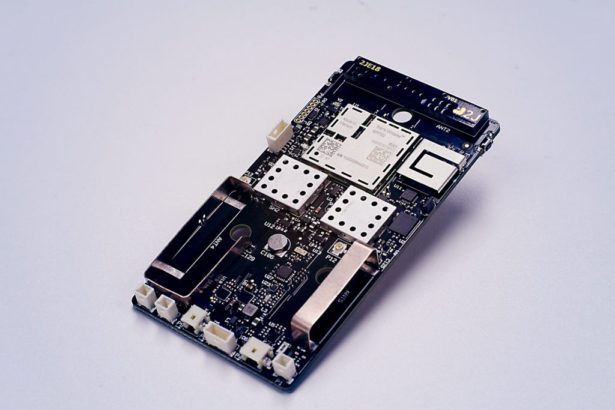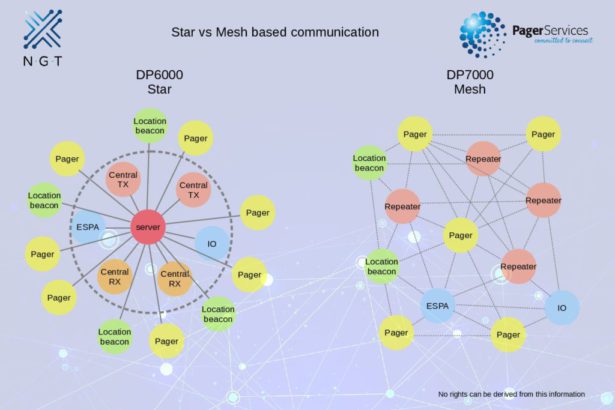
DP7000 explained
The current DP6000 paging systems are all based on a star topology. A DP6000 system consists of a central server, some peripherals (transmitter/receiver) and a set of pagers. For small systems this central equipment increases the cost substantially. For large and critical systems redundancy can be complex and expensive. Therefore the development of DP7000 has recently started. DP7000 will co-exist next to DP6000 rather than directly replace it.
The DP7000 system is based on a mesh topology rather than a star topology. All devices connected to DP7000 are called nodes. A node can be a pager, but also a repeater, monitor, ESPA coupler and so on. Key is that every node works autonomously. No single node is dependent on another node to function (although a single functioning node that is out of reach of other nodes is probably not very useful). The strength of this method is obviously that there is no single point of failure. If one node is taken out, other nodes will continue functioning. Compare that to a star based topology, where the complete system is not functioning when the central server is not functioning.
Drawback of the mesh topology is that it is much harder to detect if nodes are not in reach or not functioning. There is no central server monitoring this. DP7000 provides several custom techniques to overcome this problem, where scanning of nodes and technical alarms are still possible. Also visualization of the status of nodes and active logging are still possible due to the extended DP7000 features.

Advantage of the mesh topology is that no hardwired infrastructure is necessary. All nodes communicate to other nodes directly, without central transmitters / receivers. DP7000 can be used with the same licensed frequencies as DP6000, but also with the license free LPD433 UHF band. Transmitters in the pager nodes have however much less power compared to central transmitters. So in order to guarantee coverage special repeater nodes must be placed at strategic places. These repeater nodes repeat messages from other nodes and can have higher power transmitters. If the total mesh is sufficiently dense, failure of one or several repeater nodes will have no influence on the coverage.
Similarly locator nodes can be used to have localization of other nodes. A pager node can also be programmed to act when a certain locator node is passed. Or the locator node acts when a certain pager node is passing. The DP7000 system is extremely flexible with regard to location technology.

Due to the absence of central equipment and hardwired infrastructure the installation of a DP7000 system is very easy. Small systems can be very cost-effective; a system consisting of only a few pagers combined with an ESPA node could be used to couple into a small fire alarm system. But the system can also be scaled easily to very large systems with many paging nodes, repeater nodes and locator nodes. Due to self checking of nodes and scanning of nodes the maintenance costs can be low. 24/7 support will be no longer necessary for many sites since the system will always continue working. If a node is malfunctioning, temporarily use a spare one and send the broken node for repair.
The difference between the classical DP6000 (star) and the new DP7000 (mesh) can be found here: Star vs mesh.
Current status
Currently we are developing the DP7000 system. We expect to start in house testing of the first DP7000 nodes in Q3-2021 and expect to run a few customer pilots in Q4-2021. Fully tested and certified nodes are not expected to sell before 2022 however.

The future of paging
Since the introduction of modern smart phones, the classical pager has obtained a reputation of being old fashioned. Some say that the classical pager is dead and will be replaced by smart phones. We at Pager Services have a different view on this…
Read More >>

Development of our next generation pagers (Part 1)
The development of our next generation pager is running at full speed.
Read More >>

Development of a new communication server
A completely new communication server has been developed by Pager Services to replace the old Alphadesk server.
Read More >>